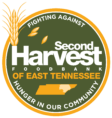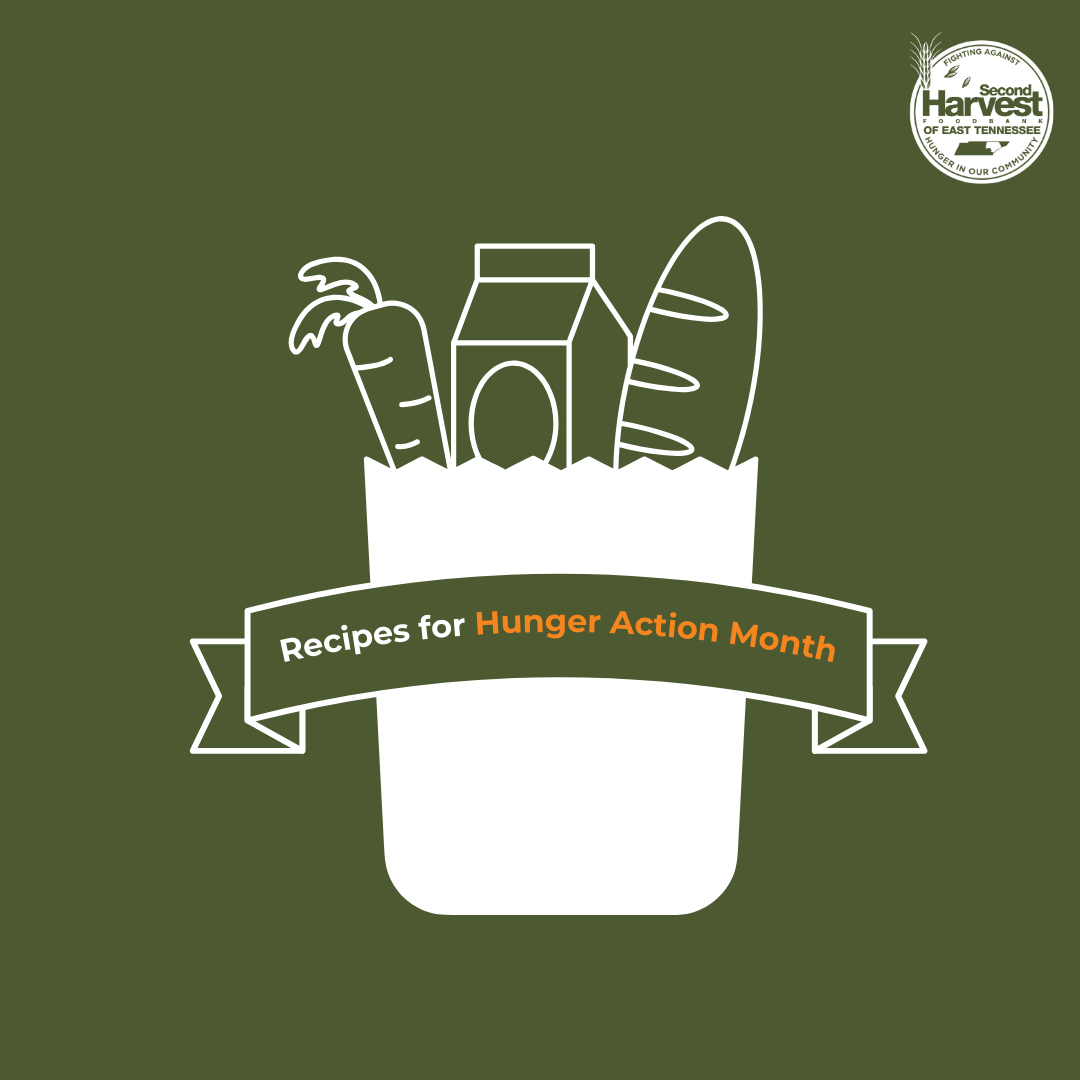Happy Hunger Action Month! Want to be a Hunger Action Hero this September by following a recipe for yourself or your family? As we highlight the importance of shelf-stable proteins this H.A.M., we’ve got two unique and tasty options from our Nutritionist to choose from, which we’ll share recipes for later on in this blog:
- Noodles with Peanut Butter Sauce (Vegetarian-friendly)
- Veggie Loaded Tuna Salad
Through our Nutrition Access team’s kids programming, called the Good EaTN Cooking Club, recipe #1 is often taught to children in the form of a cooking class. This recipe is a great option for our programming due to it using mostly food bank ingredients. Cooking classes through our Nutrition Access program occur out in our 18-county service area at partnering locations, or as field trips to our facility’s Nutrition Learning Center. Recipe #2 is a go-to for our senior population, through a cooking class catered just to their needs, titled Seasoned to Taste.
Our cooking classes strive to improve food literacy and inspire creativity, exploration, & confidence in the kitchen whilst fostering healthy relationships with food & cooking.
Want to get involved in our live, hands-on cooking experiences? In addition to Good EaTN Cooking Club and Seasoned to Taste, here are some others we offer:
- CookAbility is an inclusive cooking class tailored to the diverse needs and abilities of adults with intellectual, developmental, &/or physical disabilities.
- Cooking With Zest is a cooking class for our neighbors admitted in rehabilitation and recovery services.
- Spilled Milk (formerly Kitchen Stork Program) is a cooking class for new and expecting families.
- Good EaTN Cook-Alongs are for Second Harvest agency partners.
Our Nutrition Access Program aims to improve access to foods that align with our neighbors’ preferences and nourish their physical, mental, & spiritual well-being. In addition to cooking classes, we serve our neighbors through educational resources, community outreach, and agency partnerships.
In light of both Hunger Action Month’s and our Nutrition Access program’s education efforts, here are some Fun Food Facts about recipe #1:
Peanuts:
- Peanuts are legumes that grow under the ground. Peanut butter is made from peanuts crushed up into a paste. Peanuts have protein & oils, which can support growth.
- Store according to package instructions. Peanuts are one of the nine major allergens.
- Other uses for peanuts: Add shelled peanuts to trail mix. Chop up & top on salads, pasta dishes, & desserts.
- Other uses for peanut butter: Add in sweet desserts; peanut butter pairs well with chocolate. Stir into soups to add a nutty flavor & creamy texture. Spread on bread with mashed banana. Mix with honey to make a fruit dip. Combine with water to make a sauce for pasta or poultry.
Broccoli:
- Broccoli is a vegetable (actually, it’s technically a flower!) with nutrients like iron, vitamin K, & vitamin C which can support heart, skin, & immune health.
- Store in refrigerator for up to 2 weeks. Wash before use.
- Other uses: Roast in the oven & serve as a side. Stir-fry with other vegetables & serve over rice. Pan-fry & add to pasta dishes. Eat raw in a salad or as a snack with dip.
Carrots:
- Carrots are root vegetables with nutrients like beta-carotene & potassium that support good eye & heart health.
- Store in refrigerator for up to 2 weeks. Wash before use.
- Other uses: Slice into sticks & eat raw as a snack. Dice with celery & onions to add to bases for soups & sauces. Grate over salads. Roast in the oven & serve as a side. Stir-fry with other vegetables & sauce & serve over rice.
Ready to make recipe #1? Here’s some important information about making Noodles with Peanut Butter Sauce:
- Prep time: 10 minutes
- Cook time: 20 minutes
- Total time: 30 minutes
- Servings: 8
Let’s get started! Here’s what you’ll need:
- 1 (16-oz) package long pasta, such as spaghetti, fettuccini, or ramen
- 1⁄4 cup peanut butter
- 1⁄4 cup warm water
- 1⁄4 cup low-sodium soy sauce
- 1 Tbsp apple cider vinegar
- 4 tsp sugar
- 1 broccoli crown, scrubbed with clean vegetable brush under running water & chopped into bite-size pieces
- 1 clove garlic, minced
- 1 carrot, scrubbed with clean vegetable brush under running water & grated
- 2 Tbsp vegetable oil
Directions:
- Wash hands with soap & water. Sanitize surfaces before starting. Use clean utensils.
- Cook pasta according to the instructions on the package. Set aside.
- In a medium bowl, combine peanut butter & warm water. Stir into a smooth, thin sauce.
- Add soy sauce, vinegar, & sugar to the peanut butter mixture. Mix until sugar dissolves.
- In a large pan, heat oil over medium-high heat. Add broccoli to the pan & sauté for 3 – 5 minutes until bright green & cooked throughout. Stir in garlic & cook for 1 minute.
- Lower the heat to medium & add cooked pasta, peanut butter sauce, & grated carrot to the pan. Stir until thoroughly mixed. Gently warm.
- Serve warm. Store leftovers in an airtight container in the fridge for 3-5 days.
Reheat leftovers to 165°F.
Want to save recipe #1 for later? Click here for a PDF.
Keep reading for some Fun Food Facts about recipe #2:
Tuna:
- Tuna is an animal protein with nutrients like protein & omega-3 fatty acids, which support tissue growth & eye, brain, & heart health.
- Choose tuna packed in water instead of oil to keep more omega-3s in the fish after you drain it.
- Other uses: Add to pasta dishes or sprinkle on top of salads for extra protein & tangy flavor.
Bell Pepper:
- Bell peppers are vegetables with nutrients like vitamin C & potassium, which support immune & heart health.
- Store in plastic bag in refrigerator for up to 5 days. Wash before use.
- Other uses: slice & sauté with spices to add to Southwestern-style meals. Dice & add to soups & salads for extra crunch & flavor. Stuff with lean ground beef, rice, & spices to make stuffed peppers. Slice & eat raw with bean dip as a snack.
Celery:
- Celery is a vegetable with nutrients that help protect against cell damage & regulate healthy blood sugar levels.
- Store in a plastic bag in the refrigerator for a week or more. Wash before use.
- Other uses: Spread peanut butter onto stalks for a snack. Dice & combine with diced carrot & onion to make a starter for soups & other dishes. Boil & simmer with spices & other vegetables to make a broth.
Ready to make recipe #2? Here’s some important information about making Veggie Loaded Tuna Salad:
- Prep time: 15 minutes
- Total time: 15 minutes
- Servings: 3
Let’s get started! Here’s what you’ll need:
- 2 (5-oz) cans tuna, drained*
- 1⁄2 red or orange bell pepper, scrubbed with clean vegetable brush under running water & chopped
- 1 stalk celery, scrubbed with clean vegetable brush under running water & chopped
- 1⁄2 small red onion, chopped
- 1 carrot, scrubbed with clean vegetable brush under running water & shredded
- 1⁄4 cup mayonnaise
- 2 Tbsp dill relish (optional)
- 1 Tbsp yellow mustard** (optional)
- salt & pepper, to taste
*Or use 1 (10-oz) double can tuna
**Try using Dijon, spicy, or honey mustard for a flavor twist
Not a fan of tuna? Replace the tuna with canned or shredded cooked chicken to make chicken salad instead.
Directions:
- Wash hands with soap & water. Sanitize surfaces before starting. Use clean utensils.
- In a medium bowl, mix vegetables with drained tuna. Add relish & mustard, if using.
- Add just enough mayonnaise so the tuna salad binds together. Mix & add more mayo if needed. Add salt & pepper to taste.
- Serve immediately as-is, on bread, or with crackers. Store leftovers in an airtight container in the fridge for 2-3 days.
Want to save recipe #2 for later? Click here for a PDF.
As we wrap up Hunger Action Month, we hope you take some time to enjoy preparing these recipes, and reflect upon what it means to be a Hunger Action Hero. There are only a few days left in this month’s advocacy and awareness campaign, so we encourage you to use the remainder of September to spread the word about food insecurity in East Tennessee, sign-up to volunteer with Second Harvest, or host a food drive to collect donations.
For more information on 2024’s Hunger Action Month campaign, click here.
Did you successfully chef-it-up this #HungerActionMonth? Share how your take on these recipe(s) turned out on social media for a chance to be featured on ours! Tag us on:
Facebook: @Second.Harvest.ETN
Instagram: @secondharvestetn
For more information on our Nutrition Access program, click here or contact our Nutritionist, Courtney, via email at courtney@secondharvestetn.org.
Visit our Youtube channel to find cooking demonstrations and more!

